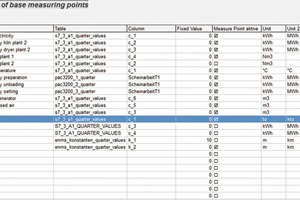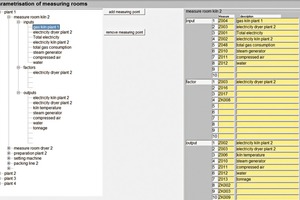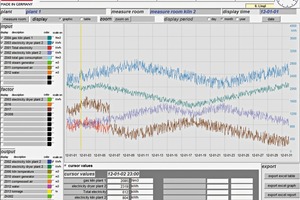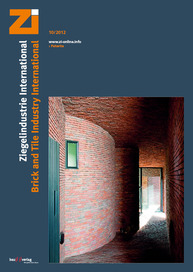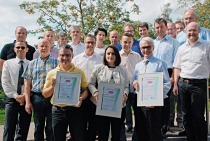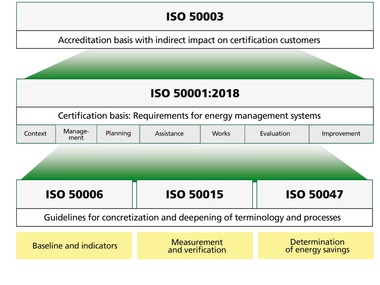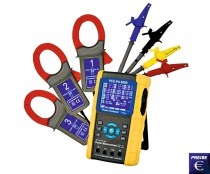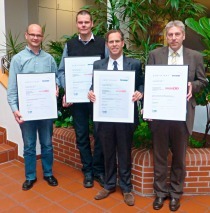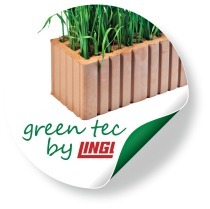Integrated approach for energy management in accordance with DIN EN16001 or ISO 50001
utilize different management systems to check and control their procedures. Weekly production and target schedules to determine procedures or other aims to achieve further business objectives could be seen as an example of this. Examples of standardized management systems that have been implemented successfully by a number of companies are:
The standard for the Energy Management EN 16001 was the basis for Environmental Management in the same way as the structure of the ISO 14001 had been built on ISO 9001. DIN EN ISO 50001 was, in great part, taken from DIN EN 16001 for internationalization purposes. It has had full validity since July 2011 and will replace the standard DIN EN 16001 in 2012 with a transitional phase to the end of April 2013.
Reasons for introducing an Energy Management System
Statutory compensation schemes, which, in Germany, will only be available to companies and organizations that have introduced Energy Management in accordance with ISO 50001 after 2013, are further substantial incentives.
The plant manufacturer Lingl, a specialist in all areas of the value creation chain in the production of ceramic building materials, will be able to give competent support to plant operators in the introduction and implementation of an Energy Management System. Our know-how covers three aspects:
1 Engineering
1.1. Example Tunnel Kiln
In general, no additional equipment, neither in the form of measuring equipment nor monitoring software, is necessary at the time of certification (first audit). At this point in time, it is, however, of great importance to clearly present the energy and production flow in the measuring rooms. It is advantageous if proposals that are to be presented in future annual audits are already prepared for this first audit, such as:
2 Energy Monitoring Software (EMS)
It is imperative that consumption and corresponding production data is collated at the latest by the first monitoring audit after successful certification.
There are a number of software tools available for energy monitoring in today’s market. However, after closer inspection it became apparent that these readily available programs are Expert systems and, unfortunately, do not have all necessary functions. A key factor of “live” energy monitoring software is the ability to expand recording and evaluation of any particular level of detail for energy management, which can only be achieved with suitable basic knowledge in the PLC technology and parameter functionality. The software needs to have sufficient parameterization flexibility to cover the adage “Who knows today what factors will be relevant tomorrow” (»1)
Simatic S7-modules read and format the digital and analogue values. A database concentrator reads this via an OPC-server connection and archives the results in a SQL-server database. Lingl includes an extensive S7-function block pool for necessary expansions.
The following control modules are necessary:
As only a small number of manufacturing units are equipped with the latest control components, older control systems (i.e. Simatic S5) are also evaluated. At the point of service delivery a decision will be made whether it is more sensible to collate the data from various control generations or whether it would be easier to install intelligent terminals and to link these to a Simatic S7.
The measuring positions can be assigned to one or several measuring rooms once they have been defined in the EMS (»2).
From this point onwards, the measuring values can be displayed in full graphic or tabular form on the display screen (»3).
The following display functions are available:
The server software can be run on a standard PC without any special CPU and storage requirements. All data is stored locally on the server PC. The necessary data safety for complete energy management can be guaranteed with the automatic local database safety or on a separate server.
The philosophy of the EN 50001 is that all employees of the company are aware of energy management and that everyone contributes in their own way towards this as well as taking this forward. Software design has taken this into consideration enabling operation for several clients simultaneously. Password-dependent user authorization enables user-friendly software operations.
3 Hardware installation
4 Summary
cesses for future investments. The continuous internal improvement process to minimize energy consumption requires user-friendly and expandable software. Apart from this software, Lingl also offers support by working out concepts and projects to save energy. This provides an optimum basis for the introduction of active energy management.
The Energy Monitoring System is a “green tec by Lingl” product. Lingl has chosen this concept to summarize all innovations for efficient production technology and optimized processes for the heavy ceramic value creation chain. The aim of these developments is to substantially reduce environmental impact and to reduce operating costs long-term. Other tried and tested solutions and products under the label “green tec by Lingl” will be published in the coming months.

